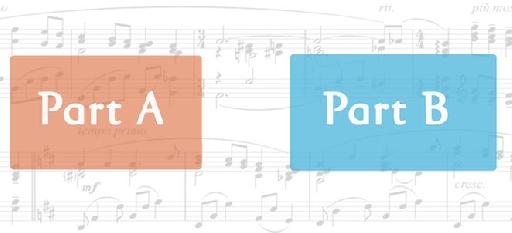其中一个我的学生们制作的各种挑战伊夫遇到在我的写作过程和写作过程是创建一个由两部分组成的和弦进行安排。它往往容易想出了一系列的两个,三个或四个和弦的循环,并建立一个有效的槽部分A但是,当谈到时间来过渡到下一部分,无论是一首流行歌曲合唱或器乐安排的B部分,它并不总是那么直观哪里拿的歌曲。对于一件事,有一个选择众多,而且可以恐吓!
当我在这篇文章中谈A部分和B部分,你可以把这些零部件的诗歌和合唱团在例如标准的流行歌曲。有音乐的许多流派和风格安排的。对于本文的目的,我将探索创造性的方式来发展你的歌和声从一个零件到下一有效地利用和弦进行创建更动态的安排。希望这些例子可以帮助你想出创造性的办法来解决谐波挑战你的安排,不管你创造的音乐类型。
A部分进展
让我们先从一个简单的A部分的8小节线进行C大:
继承人的部分和弦进程起到了一个简单的节拍:
部分和弦进行I-IV-I-IV-I-IV-IV
[音频ID =“28982”]
随着我们向前迈进,从这里,请记住,一个强大的的旋律往往决定了和弦和节奏的运动。这是我能在另一篇文章盖。本文中的例子将是不一定有一个旋律和工作只有和弦的立场有所帮助。它也是重要的注意,我用的和弦转位和声音的和弦,而不是根进展和弦之间的领先。
让我们来看看一些选项...
远离í和弦B部分
如果我们停留在C大调的关键不从其他主要借用和弦,有7个基本和弦,从建设基本和弦的时候可以选择:
í C大调
二 D小调
三 E小调
四 F大调
V G大调
六 A小调
七 乙不减
A部分的进展在很大程度上依赖于保健品或I和弦这样一个选项为B部分是避免在I和弦完全和实验与他人。下面有使用四个弦杆的一个例子,以创建部分B:II-V-II-IV-II-VI-II-V。这种发展在很大程度上依赖于IV,VI和占主导地位的V和弦之间的次要II和弦交替。因为我避免在I和弦,有一个升降或行驶感觉B部分可以把它看作我们的大本营旅游而不是来休息,直到A部分又重新开始。为了让事情更有趣,我改变了节奏有点按住II和弦的进展,而不是改变每个和弦的小节开始的开始。另外,我创建的和弦之间的快速变化。
听A部分的一个例子这个B部分进展,然后再返回到A部分:
[音频ID =“28984”]
下面有与余弦被取代为IV和VI的和弦在前面的例子中的其他选项。你会听到在使用第四和第六,在第一个例子中,并在第二次的I和弦的进展的感觉明显不同。
B部分 - II-V-II-I-II-I-II-V
[音频ID =“28983”]
获取带有欺骗性的六弦
通常情况下,你会发现一个占主导地位的和弦(V或VII),甚至是补品和弦(一)在部分或抑扬顿挫的结尾。在一个欺骗性的节奏,一节一六和弦结束,渴望创造或中止的感觉。这个节奏是使用了大量的古典音乐和现代音乐的电影,但也可以在写歌有效利用。 4和弦,你会听到如下超过800条出场两次。
B部分的IV-IV-VI-IV-IV-VI
[音频ID =“28985”]
三,作为备用主和弦
在第三弦被认为是在一个统一的尺度备用主和弦,是一个有趣的和弦尝试,而不是在I和弦。但是,由于其较小的,并与在下面的进展的六弦组合使用时,B部分得到一个更能反映感觉上占主导地位的终结,使这首歌回到A部分的幸福感前
B部分VI-III-IV-III-VI-III-IV-V
[音频ID =“28986”]
一次借
如果您选择用无聊的7个基本和弦,可以在关键选项中的youre,开始取代从音质好等调性和弦玩耍。的时候,我偶然发现的和弦进行,而意外干扰。当我碰到了什么东西,我喜欢,我弄不清什么重要进出口集中在哪些关键借来的和弦有可能从完成我的谐波和旋律的画面。在下面的示例中,我使用了一个重大III和弦,这是未成年人的优势或V和弦。 A小调是C大调的相对较小的,这样的替代效果很好。在B部分的下半年,我才回到A部分重新建立home键和节奏
B部分借来的和弦
[音频ID =“28987”]
找到你的和弦!
未来与谐波安排需要时间和实践。我的建议是让自己尝试在键盘上,无论是在关键的还是自由,找到你共鸣的和弦进行。本书还找到灵感来自最喜爱的艺术家学习分数或铅片。那里有在模仿其他艺人的想法,然后找到自己的差异并不可耻。这是一个伟大的方式来开发你的耳朵。当你尝试,你可能会听到完美的旋律,同时播放的和弦,然后你知道你将有一些特别的东西。



 © 2024 Ask.Audio
A NonLinear Educating Company
© 2024 Ask.Audio
A NonLinear Educating Company
Discussion
Moving to a different set of chords for a chorus or second part goes without saying, but I never considered writing around the tonic as a useful device for heightening the sense of movement. Then there's that pesky iii chord. Best description I've read on its functionality yet. Thank you. Now my search continues for the answer to today's question.
Want to join the discussion?
Create an account or login to get started!